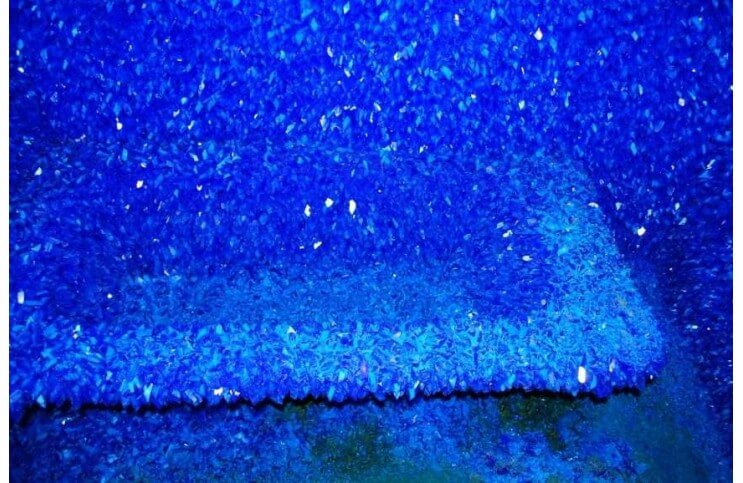Blue and Abstract Art
Apr 13, 2016
For centuries, the color blue has been a source of fascination for artists and art lovers alike. Difficult and expensive to procure, blue was seldom seen outside the clothing of royals, religious figures, or otherwise wealthy elites in medieval and renaissance art and even then it was used sparingly. The pigment used to create blue paint was derived from the semi-precious stone lapis lazuli, which was imported at great expense from a region in northern Afghanistan. The scarcity of the color quickly established blue as a symbol of not only material wealth, but also spirituality. Even as synthetic pigments made the color more accessible, blue retained its status as a powerful, expressive, and elemental color, playing a central role in art history. It is hardly surprising, then, that in the realm of abstract art, where color is all the more powerful for its freedom from the constraints of figuration, blue has delivered some of the greatest masterpieces.
Blue Nudes
Indeed, from the beginning of the 20th century onwards, the road to abstraction was, for many artists, paved with blue. French artist Henri Matisse was at the forefront of the development of avant-garde art, his Blue Nudes a testimony to the importance of the color in his work. The images, amongst the most iconic works of early 20th century art, consist of a series of female nudes, recognizable though partially abstracted, rendered in blue paper pasted onto a white background. Working in a way that the artist termed “cutting directly into color”, by choosing a single color for the piece, Matisse reduced the works to their most powerful and elementary form.
 Henri Matisse - Blue Nude, 1952
Henri Matisse - Blue Nude, 1952
The Blue Rider
Shortly after Matisse’s Blue Nudes were realized, the Expressionist artistic group “Der Blaue Reiter” (which translates as “The Blue Rider”) came into being, founded by artists Franz Marc and Wassily Kandinsky, later joined by Paul Klee, Alexej von Jawlensky, and August Macke. The group was born of the pair’s shared fascination with the color blue and the motif of horse and rider, and saw a number of important blue-inspired works created over the short course of its existence. Kandinsky’s career-long love affair with the color blue was based on what he saw as its emotive potential and spiritual capacities. For Kandinsky, the deeper the blue, “the more it awakens human desire for the eternal”. Indeed, deep shades of blue punctuate many of the painter’s most powerful works, imbuing the images with a numinous sense and poignancy that the artist aimed to convey.
 Franz Marc - The Large Blue Horses, 1911
Franz Marc - The Large Blue Horses, 1911
Yves Klein
Later in the 20th century the color blue took center stage once again, through the work of French painter Yves Klein. Klein, whose career was defined by his preoccupation with color in its purest forms, pushed the limits of artistic creation with the fabrication of his first fully monochrome canvases in 1947. These works, defying artistic convention, were originally created in a full range of colors, however as time went by the artist became increasingly fixated on finding a particular shade of ultramarine blue, which he believed would capture the quality of pure space. Once he developed the perfect shade, known as IKB, or International Klein Blue, he patented the color, and went on to produce around 200 canvases painted with the shade, going so far as to paint nude models with the color and instruct them to roll around on a canvas to create abstract and highly expressive compositions.
 Yves Klein - IKB 191, 1962
Yves Klein - IKB 191, 1962
Roger Hiorns and Blue Abstract Art
More than half a century after Klein created his first IKB canvasses, the color blue continues to lead the way in the realm of boundary-pushing non-figurative art. For contemporary artist Roger Hiorns, a former council flat in London was the canvas for his blue masterpiece, Seizure, created by covering the small bedsit with copper sulphate solution. Striking blue crystals were then allowed to form over every surface of the space. The piece, which was nominated for the Turner Prize in 2009, demonstrates the enduring power of the color in contemporary art.
Whether a symbol of spirituality or material wealth, sadness or strength, space or emptiness, there is no doubt that the color blue has served as inspiration for artists throughout the ages. Leaving a lasting mark on the history of abstract art, the once precious shade has been democratized but not diluted, its elemental power and expressive potential providing inspiration to artists from Mondrian to Malevich, Kandinsky to Klee, and Picasso to Pollock.
Featured Image: Roger Hiorns - Seizure




